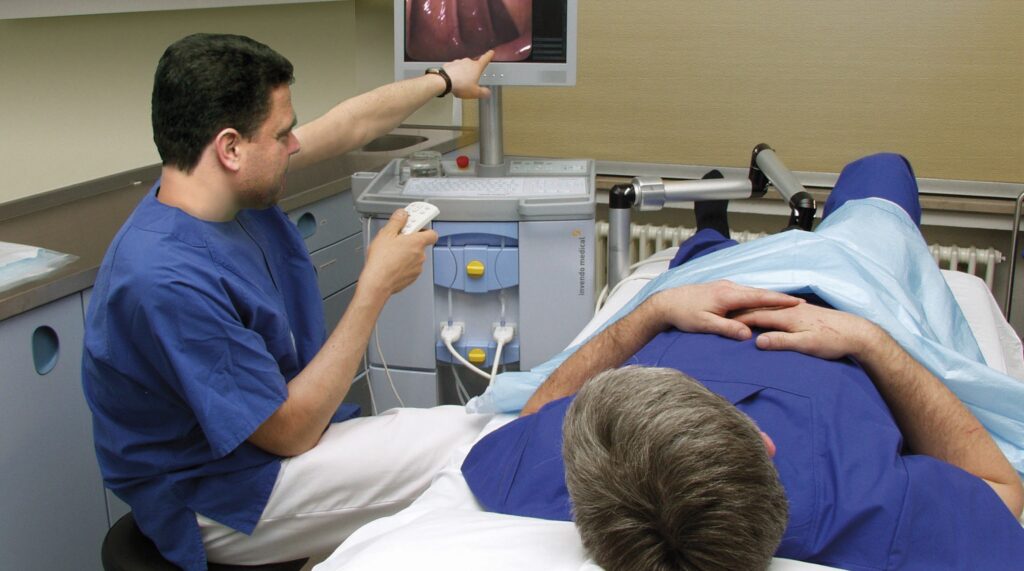Most testicular cancers can be found at an early stage. In some men, early testicular cancers cause symptoms that lead them to seek medical attention. Most of the time a lump on the testicle is the first symptom, or the testicle might be swollen or larger than normal. But some testicular cancers may not cause symptoms until after they have reached an advanced stage.
More doctors agree that examining a man’s testicles should be apart of a general physical exam. The American Cancer Society (ACS) recommends a testicular exam as part of a routine cancer-related checkup.
The ACS advises men to be aware of testicular cancer and to see a doctor right away if they find a lump in a testicle. Because regular testicular self-exams have not been studied enough to show they reduce the death rate from this cancer, the ACS does not have a recommendation on regular testicular self-exams for all men. However, some doctors recommend that all men examine their testicles monthly after puberty.
Each man has to decide for himself whether or not to examine his testicles monthly, so instructions for testicular exams are included in this. If you have certain risk factors that increase your chance of developing testicular cancer (such as an undescended testicle, previous germ cell tumor in one testicle, or a family history), you should seriously consider monthly self-exams and talk about it with your doctor.
Testicular Self-Exam
The best time for you to exam your testicles is during or after a bath or shower, when the skin of the scrotum is relaxed.
It’s normal for one testicle to be slightly larger than the other, and for one to hang lower than the other. You should also be aware that each normal testicle has a small, coiled tube called the epididymis that can feel like a small bump on the upper or middle outer side of the testis. Normal testicles also contain blood vessels, supporting tissues and tubes that carry sperm. Some men may confuse these with abnormal lumps at first. If you have any concerns, ask your doctor.
A testicle can get larger for many reasons other than cancer. For example, fluid can collect around the testicle to form a benign condition called a hydrocele. Or the veins of the testicle can dilate and cause enlargement and lumpiness around the testicle. This is called a varicocele. If your testicle seems larger, have a doctor examine you to be sure you have one of these conditions and not a tumor. The doctor may order an ultrasound exam. This is an easy and painless way of finding a tumor.
If you choose to examine your testicles regularly, you will become familiar with what is normal and what is different. Always report any changes to your doctor without delay.
Signs and Symptoms of Testicular Cancer
If you have any of these signs or symptoms, see your doctor without delay. Many of these symptoms are more likely to be caused by something other than testicular cancer.
But if a tumor is the cause, the sooner it is found, the sooner you can start treatment and the more effective it is likely to be.
Lump or Swelling in the Testicle
Most often, the first symptom of testicular cancer is a lump on the testicle, or the testicle becomes swollen or larger. Some testicular tumors might cause pain, but most of the time they do not. Men with testicular cancer can also have a feeling of heaviness or aching in the lower abdomen or scrotum.
Breast Growth or Soreness
In rare cases, germ cell tumors can make breasts grow or become sore. This occurs because certain types of germ cell tumors secrete high levels called human chorionic gondotropin (HCG), which stimulates breast development.
Some Leydig cell tumors can make estrogens (female sex hormones), which can cause breast growth or loss of sexual desire.
Early Puberty in Boys
Some Leydig cell tumors can make androgens (male sex hormones). Androgen-producing tumors may not cause any specific symptoms in men, but in boys they can cause signs of puberty at an abnormally early age, such as deepening voice and the growth of facial and body hair.
Symptoms of Advanced Testicular Cancers
Even if testicular cancer has spread to other parts of the body, many men might not have symptoms right away. But some men might have some of the following symptoms:
- Low back pain, from cancer spread to the lymph nodes (bean-sized collections of immune cells) in back of the belly
- Shortness of breath, chest pain, or a cough (even coughing up blood) may develop from cancer spread in the lungs.
- Belly pain, either from enlarged lymph nodes or because the cancer has spread to the liver.
- Headaches or confusion, from cancer spread in the brain.
A number of non-cancerous conditions, such as testicle injury or inflammation, can cause symptoms similar to those of testicular cancer. Inflammation of the testicle (known as orchitis) and inflammation of the epididymis (epididymitis) can cause swelling and pain of the testicle. Both of these also can be caused by viral or bacterial infections.
Signs of Testicular Cancer
Some men with testicular cancer have no symptoms at all, and their cancer is found during medical testing for other conditions. Sometimes imaging tests done to find the cause of infertility can uncover a small testicular cancer.
How is Testicular Cancer Diagnosed?
Testicular cancer is usually found as a result of symptoms that a person is having. It can also be found as a result of tests for another condition. Often the next step is an exam by a doctor.
The doctor will feel the testicles for swelling or tenderness and for the size and location of any lumps. The doctor will also examine your abdomen, lymph nodes and other parts of your body carefully, looking for any possible signs of cancer spread. Often the results of the exam are normal aside from the testicles. If a lump or other sign of testicular cancer is found, testing is needed to look for the cause.
Ultrasound of the Testicles
An ultrasound is often the first test done if the doctor thinks you might have testicular cancer.
This test uses sound waves to produce images of internal organs. A transducer (wand-like instrument) gives off sound waves and picks up the echoes as they bounce off the organs. A computer creates an image on a monitor from the pattern of the echoes.
The pattern of the echoes can be used to distinguish certain benign conditions (like hydrocele or varicocele), from a solid tumor that could be a cancer. If the lump is solid, then it’s more likely to be a cancer, so the doctor will recommend further tests or even surgery to remove the testicle.
Ultrasound is an easy test to have and it uses no radiation. You are on your back on a table as the technicians moves the transducer along the skin of the scrotum. Usually, the skin is first lubricated with gel.
Blood Tests for Tumor Markers
Some blood tests can help diagnose testicular cancers. Many testicular cancers make high levels of certain proteins called tumor markers, such as alpha-fetoprotein (AFP) and human chorionic gonadotropin (HCG). When these tumor markers are in the blood, it suggests that there is a testicular tumor.
Rises in AFP or HCG can also help doctors tell which type of testicular cancer it might be. Non-seminomas often raise AFP and/or HCG levels. Pure seminomas occasionally raise HCG levels but never AFP levels, so any increase in AFP means that the tumor has a non-seminoma component. (Tumors can be mixed and have areas of seminoma and non-seminoma.) Sertoli and Leydig cell tumors do not make these substances. Some cancers are too small to elevate levels of these tumor markers.
A testicular tumor might also increase the levels of an enzyme called lactate dehydrogenase (LDH). LDH levels can also be increased in conditions other than cancer. A high LDH level often (but not always) indicates widespread disease.
Tumor marker tests sometimes are also used for other reasons, such as to help estimate how much cancer is present, to follow the patient’s response to treatment, or to look for signs the tumor might have returned.

